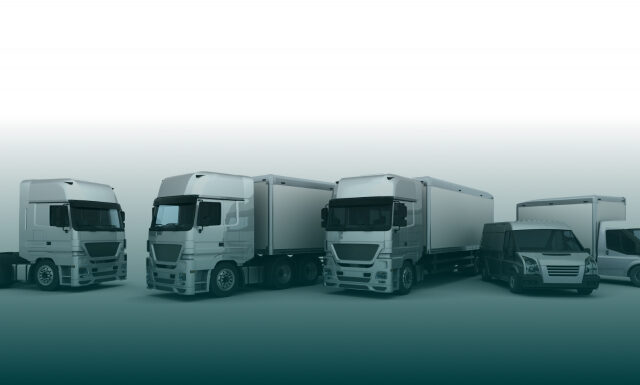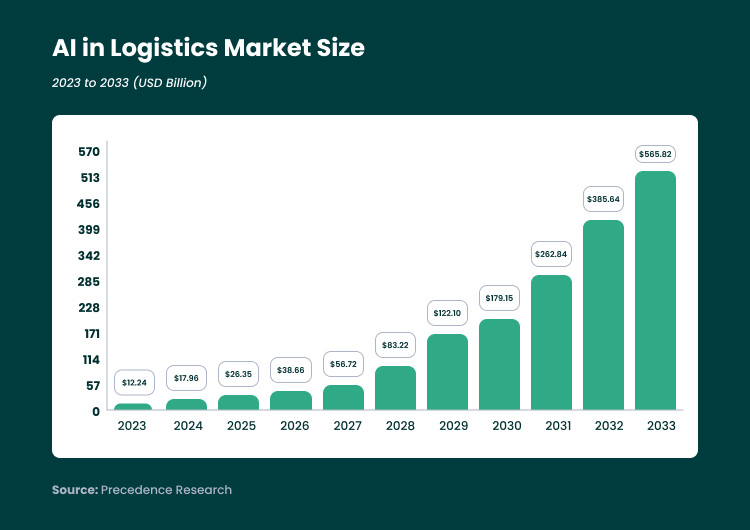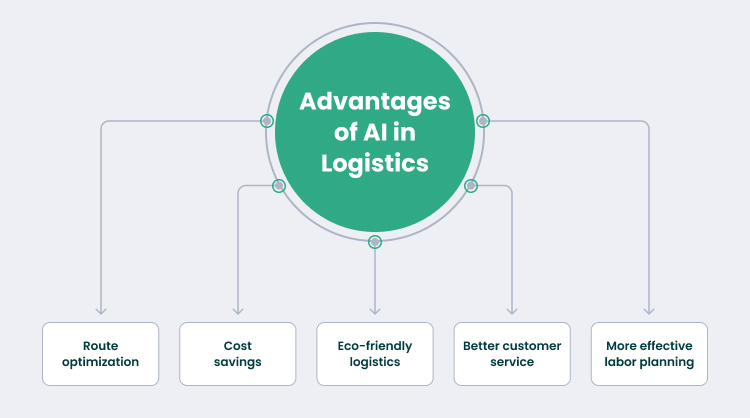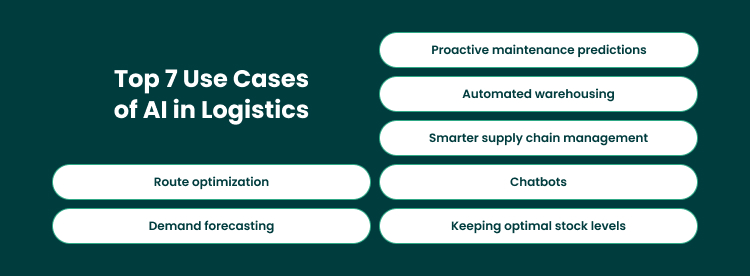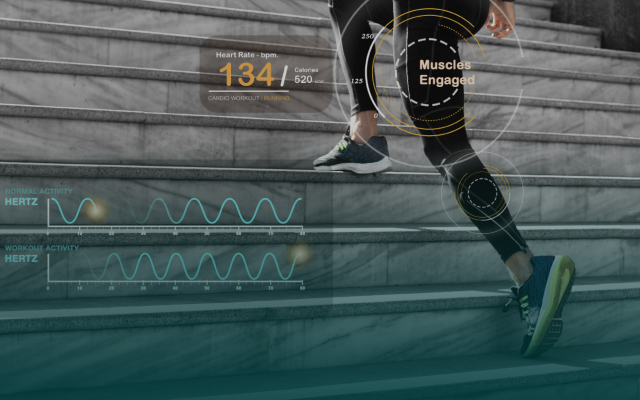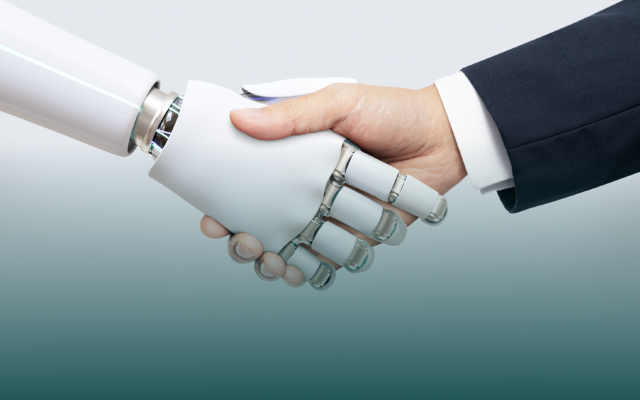Picture this: It’s 9 a.m., and a notification pops up on your phone: “Your order will be delivered by 6 p.m.”
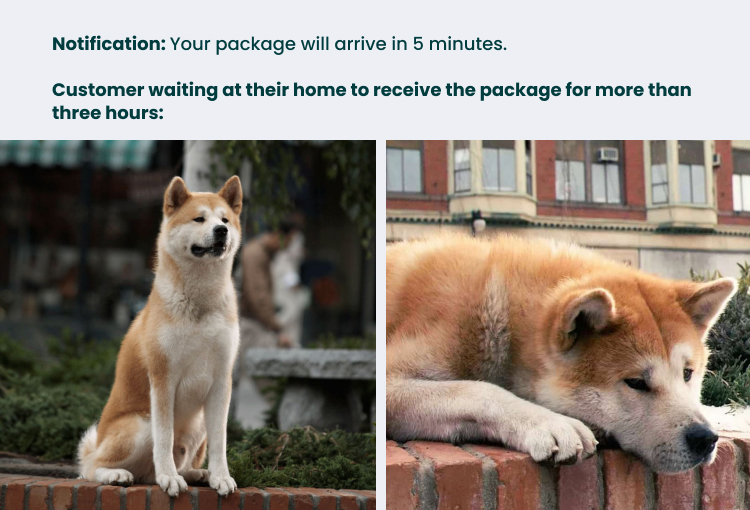
How does that make you feel? Confused? Frustrated? Maybe even annoyed? We get it. More than just speed, customers crave clarity and predictability.
Now, imagine how your clients feel if your logistics services leave them with the same uncertainty. Don’t be surprised if they turn to your competitors instead.
In logistics, this remains a major challenge – one that can affect a company’s reputation. Unfortunately, some businesses respond to it by raising prices or offering excuses, which only adds to customer frustration. No one likes waiting for deliveries or dealing with unjustified price hikes.
But there’s a better way. With AI in logistics, companies can address these issues directly. Better routes, easier inventory, accurate forecasts, and happier customers – AI offers real solutions to the challenges we’ve all faced. It’s time to leave those headaches behind.
In this article, we’ll uncover the advantages and challenges of AI logistics and how it can transform your supply chain. Let’s get started!
The Benefits AI in Logistics Brings to the Table
The global AI in logistics market is growing fast. It was worth $12.24 billion in 2023, jumped to $17.96 billion in 2024, and is expected to hit $565.82 billion by 2033, with an annual growth rate of 46.72%. This boom is driven by rapid advancements in the logistics industry worldwide.
Did you know that 57% of logistics companies around the world now use AI? They’re adopting it to save money and speed up deliveries. AI helps them with things like planning better delivery routes and predicting demand.
So, why not join them? If you’re still unsure, let’s explore how artificial intelligence in logistics can benefit you and help you make more informed decisions.
- Automation of repetitive and routine tasks. AI in logistics automates simple tasks, like picking, packing, and moving goods, which frees up employees for more important work. According to Statista, 60% of companies believe generative AI tools will transform supply chains by 2025.
- Significant cost savings. AI also helps logistics companies save money by streamlining operations. A McKinsey survey found that 44% of executives whose companies use AI have seen cost reductions.
- Eco-friendly logistics. AI in logistics can make supply chains more eco-friendly by reducing fuel use and cutting emissions. According to Accenture, artificial intelligence analyzes data from supply chains and consumer habits to optimize routes and operations.
- Better customer service. AI helps businesses improve customer service by personalizing interactions. With natural language processing (NLP) and machine learning, AI can understand customer emotions, provide relevant responses, and create chatbots that assist customers anytime, day or night.
- More effective labor planning. AI doesn’t replace workers in logistics. It just helps them do their jobs better. According to McKinsey, AI in logistics boosts productivity by 20% to 30% for field workers and 10% to 20% for schedulers.
If you’re interested in transforming your supply chain with AI in logistics, share your ideas, and we’ll get back to you with our next steps.
Barriers to the Implementation of AI in Logistics
AI in logistics is not an easy path. It’s still not fully explored and comes with hidden risks, such as integration expenses and challenges in AI adoption. Let’s review these obstacles to help you prepare to address them in advance.
- Data quality and accessibility. AI relies on clean, high-quality data, but many logistics companies struggle with inconsistent formats, missing information, and fragmented datasets. According to research, only 35% of Chief Data Officers feel adequately resourced to manage this.
- High implementation costs. AI technology demands significant upfront investments. Smaller logistics companies with limited budgets may find this daunting, especially with global spending on AI systems reaching $154 billion in 2023.
- Integration with legacy systems. Outdated systems often lack compatibility with modern AI technologies, making integration time-consuming and technically complex.
- Talent shortage. AI adoption requires skilled professionals in data science and machine learning, but 68% of executives report difficulties in hiring qualified experts.
Yes, these barriers can slow down AI adoption in logistics, but with our help, they won’t stand in your way. We’ll transform them into opportunities for growth.
Access our top-notch expertise to power your logistics software with AI and take your operations to the next level.
Top 7 Use Cases of How Companies Are Integrating AI in Logistics
AI is making big improvements in logistics. Many companies are already using it to meet specific needs. Let’s take a look at some of the best examples of how AI is being used in this industry.
Route optimization for faster deliveries
One of the most popular ways AI is used in logistics is route optimization. Simply put, AI helps companies figure out the best way to get deliveries from point A to point B. It considers traffic, weather, delivery deadlines, and real-time events to create the fastest and most efficient routes. This means less fuel, lower costs, and faster, more accurate deliveries.
Take DHL, for example. They use AI to plan their routes and make sure urgent deliveries, like medical supplies or packages, are prioritized. The system also defines the distance between stops to find the quickest way to complete the route.
Demand forecasting for streamlining operations
Let’s talk about how AI in logistics helps with demand forecasting in the industry. Companies use machine learning to predict what customers will need and when. How do they do it? By analyzing loads of data – past sales, product images, customer reviews, and even what people are searching for online.
Take Amazon, for example. They’re all about using advanced AI to get it right. They combine tools like deep learning, image recognition, and natural language processing (NLP) to figure out what customers want. It’s how they stay ahead, keeping shelves stocked and customers happy.
Proactive maintenance predictions for addressing potential issues
AI in logistics isn’t just about planning routes. It also helps companies stay ahead with proactive maintenance. Instead of waiting for trucks to break down, AI predicts issues before they happen. This means trucks stay on the road, deliveries stay on schedule, and businesses save time and money.
For example, Paccar makes big trucks for the transportation industry and uses machine learning to predict repairs before problems occur. Their trucks are equipped with smart hardware and software that analyzes data to keep everything running smoothly. It’s like giving their trucks a crystal ball for better quality and fewer disruptions.
Automated warehousing for efficient order picking and sorting
AI is changing the game for warehouses by automating operations and making everything more efficient. It helps warehouses make better use of their workers, reduces manual tasks, and cuts down on costs.
Consider Honeywell, for instance. They’ve created an AI-powered robotic system that handles order picking and sorting. This warehouse automation system works faster, more accurately, and with fewer mistakes. Plus, it saves space and manages over 20,000 products using shuttles.
Smarter supply chain management
AI in logistics helps companies make their supply chains smarter and more sustainable. It’s also a great tool for creating eco-friendly products by reducing waste and improving production.
Take Unilever, for example. They fine-tune AI to analyze real-time data from suppliers, manufacturers, and retailers, giving them a clear picture of their entire supply network. This lets them quickly avoid disruptions and keep prices steady – all while building a stronger, more reliable supply chain.
AI-powered chatbots for better customer service
Logistics companies are using AI-powered chatbots to answer customer questions and understand their preferences. This helps the chatbot suggest personalized products, making the customer experience better and opening up chances for upselling and cross-selling.
For example, UPS uses AI chatbots to improve customer service. These chatbots can answer questions about shipment status, delivery times, and more, making it easier for customers to get the information they need.
Maintaining optimal stock levels for better product distribution
Keeping the right stock levels is no easy task. Without a clear view of how products move through the supply chain, overstocking or understocking can easily happen—and that can hurt your cash flow. Older systems often can’t keep up with changing demand either.
That’s where AI in logistics comes in. It helps allocate and distribute products efficiently, so they arrive on time and in full (OTIF). This means fewer missed sales and happier customers. Plus, AI tools keep stock levels updated based on product priorities, so you’re always one step ahead.
5 Key Steps to Effectively Integrate AI into Logistics
Integrating AI into logistics might seem challenging, but breaking it down into steps can make the process much easier. Here are some simple steps to help you successfully use AI to streamline your supply chain operations. Let’s dive in!
Step 1: Align AI with your business goals
The first step for companies is to understand how AI in logistics can help with big goals, like improving efficiency or customer satisfaction. Once you know your priorities, turn them into clear, measurable goals. Set KPIs (key performance indicators) to track progress, such as reducing delivery times, cutting carbon emissions, or improving inventory accuracy.
Step 2: Recognize probable obstacles
Next, identify possible challenges. One big issue could be cost. If the budget is tight, start small by applying AI to a few processes to see how it works.
Skill gaps and resistance to change can also be problems. To overcome this, train your team or hire experts. If your staff is unsure about AI, run workshops to show how it can reduce manual work and improve efficiency.
For older companies, legacy systems might be a hurdle. You may need to upgrade your IT systems or consider cloud-based AI solutions that don’t rely too much on current infrastructure.
Step 3: Assess and choose solutions
Once you’ve identified the problem, look closely at your logistics operations to find areas where AI can help. Some common areas to start with are inventory management, warehouse optimization, or using AI for predictions.
Then, research different AI solutions. Compare them based on cost, features, and how well they fit your business. Finally, test the solution with a small pilot project (proof-of-concept) to see if it works for your needs before going all in.
Step 4: Plan AI integration strategies
To successfully integrate AI, you need a clear plan for both the technology and your data.
When choosing AI platforms, ask yourself:
- Do you need a cloud-based solution or a custom one?
- Will it work with your current systems?
- Can it grow with your business?
Once you know the answers, you’ll be ready to add AI to logistics without causing problems.
For your data, make sure it’s clean, organized, and secure. Follow legal rules and use security measures like encryption to keep it safe.
How Can Forbytes Improve Logistics with AI?
Using AI in logistics isn’t just a bonus; it’s essential for companies that want to stay ahead. AI helps businesses cut costs, meet customer needs, and become more sustainable.
At Forbytes, we specialize in AI implementation to make your operations run smoothly and boost efficiency. We create custom AI solutions that tackle your unique challenges and deliver real results. Whether it’s improving inventory management, working with suppliers, or streamlining logistics, we’re here to guide you every step of the way.
Get in touch with us today and see how we can help make your logistics operations smarter and more efficient.
